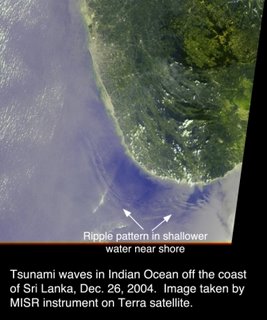
The Sri Lanka Disaster Minister is quoted by the Sunday Times (23 July 2006, p. 2) as stating that “In the wake of last week’s earthquake and subsequent tsunami in Indonesia, the country was fully prepared within 23 minutes as an early warning reached the Met Department.”
According to the 17 July timeline.ppt, the PTWC and the Japanese Center issued the first bulletin within 17 minutes of the earthquake. The Minister indicates that the entire country was fully prepared within 6 minutes of receiving that bulletin. This may possibly be a world record.
If we assume the 23 minutes was counted from the time the warning was received, the country was ready 40 minutes after the earthquake. Even that is extraordinary. The Sri Lankan official who was interviewed by the Associated Press does not seem to have been aware of this great achievement and simply talked about plans and sirens in religious establishments. It appears that the international press is badly informed or is maliciously supressing Sri Lanka’s achievements.
The Minister further stated ” all we need is 20 minutes to warn the people if they are in imminent danger since there are 15-20 disaster management officials in all coastal districts who are ready to evacuate the people.” The Times states that the disaster management personnel are mainly army, navy and air force officers who have undergone “vigorous training to evacuate people living on the coast to higher grounds which have now been identified.”“The people in these areas too are trained to follow route maps to reach safety in case of a tsunami. Police in these areas have been given megaphones to help in the process.”
The Ministry has already received funds from UNESCAP to build three tsunami warning towers in the Eastern, Northern and Southern Provinces and hopes to build another 25 towers by December 26 [2006] to mark the second anniversary of the disaster, according to the Times.
To summarize:
Sri Lanka only needs twenty minutes to act on a tsunami warning. It took precisely 23 minutes on 17 July 2006, but action is being taken to shave off 3 minutes from the response time.
There are 15-20 disaster management officials in each coastal district, mainly from the forces, giving a total of 15 x 10 = 150 in all. [One assumes different arrangements are in place for Jaffna, Mulativu, Mannar, Kilinochchi, Trinco, Batticaloa, Ampara districts which are not fully under government control]
They have identified the vulnerable populations and trained them.
They have also identified the evacuation paths and the safe locations to move the people to.
The Police, not the disaster management personnel, have been issued megaphones to assist in evacuations, suggesting close coordination between the Police and the disaster personnel.
Funds have been received for three warning towers, one each for the Northern, Eastern and Southern provinces.
Funds have not been received, but will be sought for 25 additional towers. Fund raising, procurment under government procedures and construction will be all completed within five months, giving a total of 28 operational warning towers along the coastline by 26 December 2006.
If all this is true, there is no question that Sri Lanka is the country that is best prepared for a tsunami. On this strength alone, the Disaster Minister should be nominated to a UN post, shortly after the inauguration of the 28 warning towers on 26 December 2006. We have no doubt he will be accepted with acclaim.
No comments:
Post a Comment